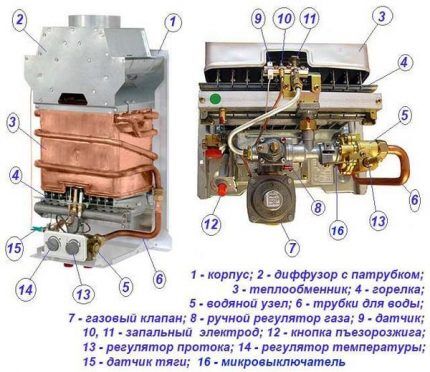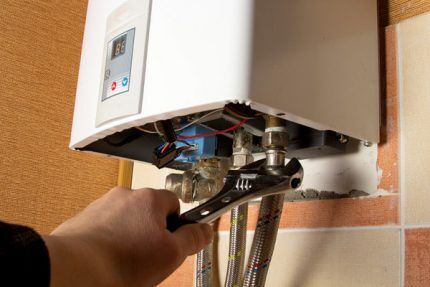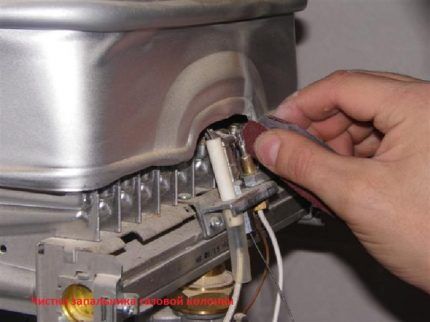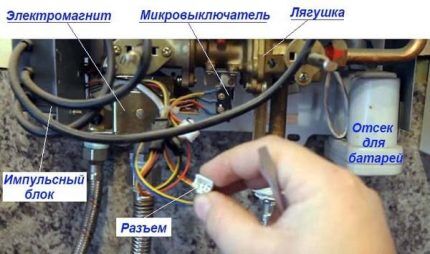Repairing a geyser heat exchanger with your own hands: the main stages of soldering a copper radiator
Instantaneous water heaters running on natural gas are fairly reliable devices that very rarely fail. Due to minor malfunctions that occur during operation of the device, a large number of inconveniences can occur. In such cases, you should call a specialist to your home or repair the geyser heat exchanger yourself to save money.
For a technician, such a procedure will not take even 5 minutes, but you will still have to pay for the call. Fixing a number of breakdowns that occur in this device is quite simple. And how to detect a breakdown and independently repair a geyser, its heat exchanger and all components - we will talk about all this in our article. We will provide detailed soldering instructions, providing the material with visual photos and useful videos.
The content of the article:
How does a water heater work and work?
To learn how to repair a gas water heater, you must first understand how it is designed and how it works.
Units can be of the following types:
- With an open combustion chamber or atmospheric.
- With a closed combustion chamber or turbocharged. They are also called inflatable.
The air required for gas combustion enters the atmospheric column from the environment naturally.It enters the device through an opening located at the bottom of the column. To remove combustion products, a chimney with natural draft is installed.
Turbocharged or inflatable columns differ from atmospheric ones in one feature: their combustion chamber is closed, and the built-in fan provides forced draft. Air inflow and exhaustion is carried out forcibly through a coaxial chimney (double-walled).
You can familiarize yourself with the structure of a gas water heater in general terms by looking at the following illustration.

Below is the operating principle of a modern gas burner with an automatic ignition system:
- The column starts working when the mixer tap is opened. The water flow passes through the water supply unit and the heat exchanger of the gas device.
- Inside the column body there is a water regulator membrane, which pushes the rod under the influence of pressure arising from the water. This allows the rod to compress the spring of the mechanical gas valve in the block to allow fuel to reach the burner itself.
- At this stage, the solenoid valve circuit is closed, which occurs when the button is released by the rod microswitch. The valve provokes the release of gas into a special tube, which is a supply tube. Gas flows to the already open spring valve.
- The pulse device is triggered. It delivers a discharge to the electrodes that are located next to the burner.Sparks are formed, as a result of which ignition begins. This allows the water passing through the heat exchanger to be heated.
The electromagnetic circuit consists of 3 sensors that are switched on in series. These include a draft, overheating and flame sensor. When the last element of the chain fixes the fire, at this moment the formation of sparks ends.
We discussed the operating principle of the column in more detail in this material.

Signs of heat exchanger failure
After you have learned in more detail about the principle of operation of a geyser, you can consider the important points necessary to successfully prevent radiator failure.
So, there are several conditions when it is necessary to repair a faulty heat exchanger of a geyser, since the unit itself begins to automatically turn off:
- Water flow stops and there is no pressure. In this case, the water regulator releases the pusher, which causes a shutdown microswitch.
- The last element of the electromagnetic circuit, that is, the ionization sensor, ceases to “see” the flame. In this situation, the corresponding signal is not given, which is why the gas path is closed by the magnetic valve.
- Draft ceases to form in the chimney. The electromagnet stops working, the electromagnetic circuit is broken and the fuel supply ceases.
- The overheating sensor stops functioning. This component of the circuit is installed directly on the heat exchanger.
After we have understood the nuances of the operation of the gas water heater and possible problems indicating a breakdown of the radiator, we will talk about how to repair it. But first we need to rule out other faults.
Eliminating other column faults
Most often, you may encounter a situation where the column does not initially ignite a flame. First you need to determine what exactly led to this. After all, the problem may not be in the heat exchanger at all, but, for example, in dead batteries. Therefore, it is impossible to do without diagnostics. Moreover, some breakdowns can be repaired with your own hands, but in some cases you will have to call specialist from the gas service.
External inspection of the water heater
Competent diagnostics will allow you to quickly carry out repairs on your own.

There are a number of basic steps that should be performed before you go to examine the inside of a water heating device:
- Replacing the battery and cleaning power contacts.
- Checking the chimney draft and availability pressure in a cold water supply system.
- Checking the fuse (for speakers with turbocharged). You can flip the plug in the switch to change the phase location - this is important for imported models, since they are quite sensitive to this.
- Cleaning the strainer. This is a dirt trap that can be found on the pipe supplying cold water. Often the mesh is a structural component of the water unit.
- Observe the ignition electrodes.To do this, just open the hot water tap, after which sparks should form. If the camera is closed, then you can listen to the body. Characteristic sounds like the clicking of charges should be heard.
The above steps may not always help. Then you have to look inside the speaker, for which you have to remove the housing.

Troubleshooting inside the column
If an external inspection and replacing the batteries did not help, then you can start troubleshooting directly inside the device.
To do this, you need to remove the water heater casing and check the main components one by one. It is better to perform all actions with an assistant. He should be asked to open the hot water, and he himself should monitor the movements of the rod. The responsibilities of this element include influencing the pressure plate to move it away from the button microswitch.
If the pusher does not perform any movements, then with a 100% probability the problem lies in the water block. If this problem occurs, you will need to disassemble the unit to clean and change the membrane in it.
Also, the rod can press on the plate, but the button will remain pressed. In this case, it is necessary to check the water regulator for scale. It should be found and cleaned.
If all of the above elements operate in normal mode, the button is pressed, but sparks are not formed, then in this situation the culprit may be the microswitch. To make sure of this, you need to disconnect its connectors and clamp the two terminals with a screwdriver. If sparks immediately begin to form in this case, then the switch is faulty and should be replaced.

The solenoid valve may also fail, causing no gas to flow. To do this, you should check each of the sensors in the circuit by short circuiting one by one. You can also use multimeter For calls.
Heat exchanger repair procedure
If traces of leaks are found inside the structure, then the problem is much more serious. A leak can form from a copper radiator in a household gas water heater, which can be caused by deformation of the tubes. It can also appear due to malfunctions in the operation of the water unit, which is typical for automatic geysers. Such a violation indicates a malfunction of the gearbox, which can cause the column to completely fail.
Hard water from the city water supply, improper connection (grounding), and frequent overheating of the column contribute to the fact that scale begins to form on the walls of the heat exchanger pipes. The material of the radiators is not particularly durable, so fistulas quickly appear on the surface of the pipeline and heat exchanger.
Owners of modern geysers very often encounter this problem. This is due to the fact that such devices use thin copper, often of low quality. To correct the problem, you can perform ordinary soldering at the site of the fistula.
Stage #1 - draining water from the radiator
It is worth noting that you cannot immediately proceed to soldering. First, you should make sure that the dispenser is disconnected from the gas and electricity supplies.
It must also be disconnected from the water supply and the heat exchanger, which contains a sufficient amount of coolant, must be completely emptied. If this simple precaution is neglected, the incoming heat will be constantly removed due to the liquid.

It is not possible to remove all the liquid from the heat exchanger using a tap. Therefore, you should unscrew the nut that is placed on the pipeline. Now all that remains is to get rid of the leftovers. For this purpose, you can use an ordinary vacuum cleaner or compressor, or you can also manually circulate air using a garden hose.
Stage #2 - soldering copper pipes
When the heat exchanger has been completely emptied, you can begin soldering. But how to properly solder a heat exchanger in a gas water heater in places where fistulas form? This is quite easy to do, since the whole process is well established. If you have never done this, we recommend that you read the instructions for soldering copper tubes.
First, you should take a fine-grain emery cloth and work it over the required area. Cleaning the fistula should be carried out until there are no oxides left. It is not difficult to determine their location, since such copper has a greenish tint.
After cleaning is completed, rub the desired area with a cloth soaked in cleaning agent. Now you can proceed directly to tinning. To do this, everyone individually selects solders for themselves.You can also take the advice of professionals who recommend using POS-61. All that remains is to take a soldering iron with a power of 0.1 kW and rosin as a flux.
If rosin is not available, you can use aspirin. It is sold at the pharmacy. It will be effective in situations where it is necessary to work with a problem area that cannot be completely cleaned.

When soldering is done on the heat exchanger of the gas column in the required place, evenly distributing the layer of solder over the area, it is necessary to increase the thickness of the homogeneous mass to 2-3 mm. Thus, the fistula will completely close and will not appear again.
In addition to the main part of the heat exchanger, the entire pipeline must be inspected. Green oxidation can also occur on copper tubing. If this problem is not corrected, then in the future it will lead to the inevitable appearance of microcracks.
It is worth noting that soldering is possible even if the smallest problem points and areas are detected. It is necessary to immediately tinning and soldering these places. If this is not done, then possible problems will arise every few months.
Soldering should be done even where it is impossible to reach. In this case, you should remove the radiator and disassemble it to get to the problem area.
Stage #3 - searching for defects after soldering
It is not always possible to detect all possible defects during a visual inspection. Even sandpaper treatment does not always give the desired result.In this case, special diagnostics, which are performed under pressure, can help.
To do this, apply a water jet inside the radiator assembly. You can use a rubber shower hose that bends well. One side of the hose should be connected to the water supply channel. The second edge is with the radiator tube. All that remains is to close one of the edges of the tube with a shut-off valve.

Now you need to turn on the faucet that feeds the water heater. During this procedure, it is important to carefully monitor the heat exchanger and all tubes. If there are barely noticeable cracks on the surface, they will immediately become visible. Water droplets will form where they are detected. The remaining areas will be dry.
In this way, it will be possible to detect all problem areas that require repair and solder them. At the same time, you can flush the radiator, ridding it of scale.
If there is a lot of damage, or the pipe material is too thin and cannot be soldered, then it will not be possible to do without large financial investments. In such a situation, you will have to purchase and install a new heat exchanger. And if the desired model is quite expensive, then you may have to think about choosing and purchasing a new speaker.
Conclusions and useful videos on the topic
In this video you can clearly see how the heat exchanger is soldered:
A video about how you can repair the heat exchanger of a column with a digital display using soldering:
There is no need to resort to self-repair of the geyser if you do not have confidence in your own abilities. First of all, it is important to understand the principle of operation of the device and adhere to safety precautions. If you do not follow the rules, you can endanger yourself and the people close to you who live with you.
Do you still have questions about heat exchanger repair that we did not cover in this material? Ask our experts in the comments section - we and other site visitors will try to help you.
If you want to share your successful experience of manually soldering a copper radiator for a speaker, tell our readers about it, add unique photos of the repair process - the feedback form is located below.



